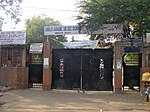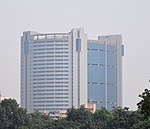New Delhi metro station
Delhi Metro stationsDelhi Metro stubsDelhi railway station stubsRailway stations in Central Delhi districtRailway stations opened in 2005 ... and 1 more
Use Indian English from July 2015

New Delhi is a station on the Yellow Line of the Delhi Metro. It is within walking distance from the Indian Railways New Delhi railway station. It is on the New Delhi Metro (Platform Number 16) side of the New Delhi Railway Station. The Airport Express also terminates at New Delhi Metro Station. Check-in facilities of some of the carriers including Air India are available at this station. A skywalk connecting the station with the New Delhi railway station was opened to the public in February 2022.
Excerpt from the Wikipedia article New Delhi metro station (License: CC BY-SA 3.0, Authors, Images).New Delhi metro station
State Entry Road, New Delhi New Delhi Railway Station (Chanakya Puri Tehsil)
Geographical coordinates (GPS) Address Nearby Places Show on map
Geographical coordinates (GPS)
| Latitude | Longitude |
|---|---|
| N 28.642229 ° | E 77.221538 ° |
Address
16
State Entry Road
110055 New Delhi, New Delhi Railway Station (Chanakya Puri Tehsil)
Delhi, India
Open on Google Maps








